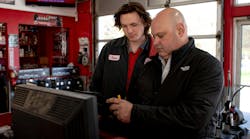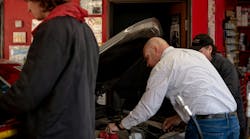There are many, many things that are well-known to just about any experienced lube shop employee — be it a long-time tech, an experienced shop manager or an owner.
However, how sure are you of your infallible knowledge of even the most simple and long-held truths about working day-to-day in any typical lube shop around the country? Let’s tackle this question from two differing perspectives: the lube shop customer and the lube shop employee.
Customer’s Lube Shop Misconceptions
We will start with the long-held beliefs by customers that may not be as cast in stone as most believe
1. All motor oil is the same
As each of you has surely heard before from some of your customers, the attitude and belief that all motor oil is the same.
Of course, we know that is not true. While each type of motor oil is, indeed, designed to meet the same performance criteria of the prevailing standard, that typically only applies to the performance capabilities of the base oil’s performance. The additive package installed by the blender is where it gets its difference. Hence, brands have the ability to claim things like, “No other oil protects like XXXXX motor oil,” and it is true insofar as how the additive package is designed. Whereas one brand may be formulated for more protection in heavy-traffic and off-road conditions, another brand may be formulated to excel in high-speed performance. It all depends on who their target customer is perceived to be.
2. 20W-50 is better than these newer lightweight oils
First of all, newer lightweight oils aren’t really all that new anymore. 5W-20 debuted in Hondas and Fords back around the year 2000.
Nowhere other than the world of automotive knowledge is the axiom “you can’t teach an old dog new tricks” more prevalent. How many times have you heard a customer claim their grandfather told them 20W-50 was better than whatever their car called for? Or, how many times have you had an older customer driving a new car exclaim, “Those engineers don’t know what they are talking about. 5W-20 is crap, put in the 20W-50.”
Typical, but we know the new oils are actually better. Educating customers on that without alienating them is the trick.
3. Transmission fluid never needs to be changed
Another popular statement from many customers is, “I have never changed the ATF in my cars and have never had a problem. It doesn’t need to be changed.”
Well, on older vehicles with a typical three-speed automatic transmission and maybe included a lock-up torque-converter, this may have been true. Older transmissions were big, heavy and relatively inefficient. They did not get as good of fuel economy as a manual transmission might have in the same type of vehicle. This was because of the looseness and slippage that was designed into them from the factory.
But, they were also durable — very durable. Ask any transmission expert about an old GM TH-400, a Ford C-6 or a Chrysler 727 torque-flite, and their first exclamation will probably be, “Those things are bulletproof. You can’t break ‘em!”(Of course that’s not true.) What they probably won’t tell you is how miserable they were as far as fuel economy goes. They just weren’t efficient enough to live on into the modern era.
Today’s sophisticated automatic transmissions are very lightweight, smaller physically than their forbearers and have many more gears within them. Yesterday’s old three-speed transmissions have given way to six- and even eight-speed automatic transmissions in today’s fuel-efficient vehicles. More gears, more complexity — all in a smaller, lighter assembly can only mean one thing: Better maintenance is required.
The old-style ATF (dexron/ mercon or type-F) was a simple recipe compared to today’s complicated ATFs. Modern ATF is required to perform much better, with more precision, provide better performance, run cooler and help a transmission last longer than old ATFs were ever intended to. ATF today is probably the most complicated fluid used in a modern vehicle. It needs to be kept clean and robust, and changing it at the specified intervals is mandatory if the car’s owner wants to get the most out their transmission.
4. I don’t need fuel-injection additive; gas has all the detergents I need
Many of your customers will make the claim the gas they buy has detergents in it and it keeps the cars injectors clean. Or they may say that since they feel the car is running great, there is no need to clean what they perceive to be a clean injector anyway.
We all know it is nearly impossible to effectively explain in two minutes or less the effects of unburned hydrocarbons on intake valves, injector pintles and ring-land grooves. It is also near impossible to get a layman customer to understand the more sophisticated a device becomes, the more stringent maintenance is required to keep it operating at peak efficiency.
Modern fuel injection systems are the perfect example of such high-maintenance requirements, and the newer direct-injection vehicles are going to prove to be the most maintenance-heavy vehicles yet — mark my words.
Employee Misconceptions
OK, that was just a few of the misconceptions we deal with in lube shops from customers, but what about some of the misconceptions lube shop employees have?
There are a few typical ones you may recognize:
1. Higher-mileage vehicles need a heavier-weight oil
How many techs out there routinely put 10W-30 motor oil into a car that might have 150,000 or 200,000 miles on it, thinking, “the tolerances on a high-mileage car have opened up a bit and it needs a higher viscosity oil to bridge the gap” — or some such BS like that?
The truth is, if a typical car was designed to run on 5W-30 or 5W-20 and has done so effectively for 150,000-plus miles without issue, like burning oil or knocking, there is certainly no reason to arbitrarily step up to another viscosity grade.
2. Customers don’t like to spend money on expensive flushes and services
I can’t tell you how many techs I have worked around over the years who would not even attempt to present a service or an expensive fluid flush to a customer because they thought it was too expensive.
This is a classic example of making decisions for the customer — the surest method to short-change your shop out of the operating profits it needs to maintain a healthy bottom line.
Face it. You are a car-guy (or car-girl), a tech, a mechanic — you know how to do this stuff on your own for less money.
But, just because you can go to the parts store and buy two gallons of coolant for $20 or less doesn’t mean performing the service for the customer at $70 or $80 is too much for them.
Remember, you have the skill to do the service, and the shop has invested in you, the tools, the products and the flush equipment to actually do the work — that all has a cost fixed to it that is figured into the price of the service to the customer.
Do not let your own preconceived notions about anything prevent you from offering to your customers whatever service their car may need or benefit from.
3. The only thing the customer cares about is the lowest price.
I saved the best for last. If you believe this to be true, then you are committing the single biggest mistake ever in the world of successful lube-shoppery. (I just made up that term.)
The only time a customer cares only about the lowest price is when there is nothing else for them to consider in their choice of where to get a service done. This cannot be overstated: If the customer knows or cares nothing about your shop, its people or its reputation, then price is the only motivating factor they have to make a choice based upon. The simple solution is simple — give them other things to base their decision on!
If your store has a neat, clean and updated appearance from the road, then that is a start.
When they drive onto the lot, if someone is outside to greet them immediately with a big smile and friendly greeting, they will like that, too.
Attentive employees who take the time to listen to what the customer has to say, shows them their opinion and their needs are heard and valued. They like that also.
Neat and well-groomed employees who speak knowledgably of the products and services go a long way toward encouraging customers to have confidence in the shop’s abilities to give them a great service.
By giving this kind of service to every customer, word-of-mouth advertising will drive other customers to your location.
The beauty of this all is, price becomes almost meaningless to the customer once they have accepted and appreciated all these other factors.
Just remember, everybody hates to pay too much for crappy products or services, but almost everyone will almost always willingly pay whatever the cost is to get what they really want.
Don’t let these lube shop misconceptions derail your day. Look forward, smile with confidence at your customers and make it happen!
KIT SULLIVAN is a partner in a multi-unit, Florida-based quick lube company. A 20-year veteran of the industry, Sullivan has more than 28 years experience in sales and management training. He is a member of the Society of Automotive Engineers and the Society of Tribologists and Lubrication Engineers. He can be reached via email: [email protected]





